5 Expert Strategies for Customer Churn Prevention That You Should Follow

If your brand is not retaining customers, no matter how many new customers you get into the metaphorical door, your business will struggle to stay afloat. Tackling customer churn is key.
Customer churn, or the rate at which customers stop doing business with a company, can significantly impact a company’s bottom line.
Remember that losing customers means not only a loss of revenue but also a loss of valuable feedback, referrals, and brand loyalty.
To reduce customer churn, companies are increasingly turning to strategies that aim to identify and address the root causes of churn before it’s too late.
In this blog, we’ll explore some of the most effective customer churn prevention strategies for your existing customers and how they can help your business retain more customers (and boost your bottom line). Let’s jump right in.
What is Customer Churn and How Does it Impact Business?
Let’s start by understanding what customer churn means.
Customer churn is basically the rate at which customers stop doing business with your company or cease using your products/services.
Churn is a common customer engagement metric that organizations use to measure customer retention and loyalty. High churn rates can have significant financial implications for a business. Let’s look at an example of what happens when customers leave. Say a customer spends $100 per month with a business and has a potential revenue value of $1,200 per year. If that customer leaves, the business loses that $1,200 in potential revenue.
High churn rates can also have strategic implications. It can indicate that a business is not meeting its customers’ needs and expectations or that its competitors are offering better products or services. This can result in a loss of market share and a weakened competitive position in the market.
Consumer brands need to understand why customers are leaving and address those issues to reduce churn and improve customer retention.
| The takeaway: Customer churn is a critical metric that businesses need to monitor closely. High churn rates can have significant financial and strategic consequences, and addressing churn is essential for improving customer retention, increasing revenue, and maintaining a competitive edge in the market. |
Identifying Why Customers Churn During Their Journey
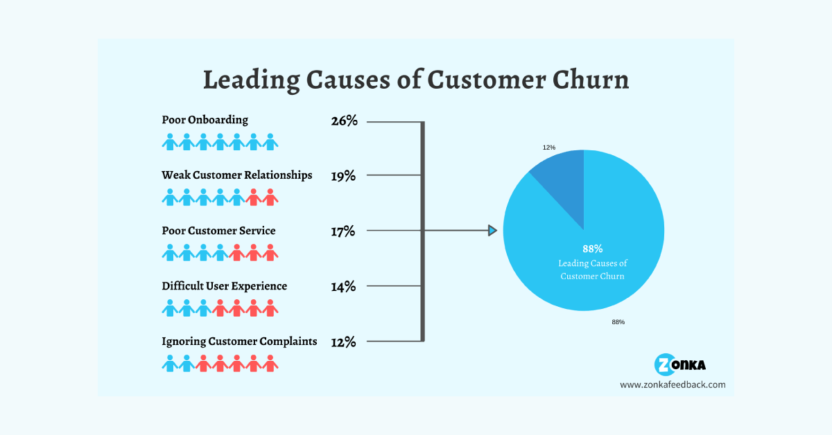
Considering that customer churn occurs when a customer ceases to do business with your company, you must focus on identifying the causes of customer churn.
Here are some common reasons why customers leave:
- Poor Customer Service: One of the primary reasons for customer churn, poor service essentially makes customers feel that the brand is not addressing their needs. In such a case, they will likely switch to a competitor providing better customer service.
- Lack of Product Innovation: If a company fails to innovate and introduce new products, customers may start looking elsewhere for better options. Product innovation can keep customers interested and engaged in your product (and, by extension, brand).
- Lack of Value: Customers want to feel that they are getting their money’s worth. If a company fails to provide quality products or services or its prices are too high, customers are likely to switch to a competitor.
- Poor Customer Experience, and Hence Retention: In today’s digital age, customers expect a seamless experience when interacting with a company’s website or mobile app. If the customer experience is poor, customers may become frustrated and seek out a better experience elsewhere. This is why brands must focus on reducing app churn rate.
- Negative Brand Reputation: A company’s reputation can greatly influence customer churn. If a company has a negative brand reputation due to scandals or controversies, customers may choose to do business with a more reputable company.
- Better Offers from Competitors: Finally, customers may leave a company if they receive better offers from a competitor. This could include better prices, products, or services.
| The takeaway: Identifying the causes of customer churn requires businesses to understand their customers’ needs and expectations and ensure that they are meeting them. By addressing these common reasons for customer churn, businesses can improve customer retention rates and increase CLTV. |
Implementing Strategies to Prevent Churn
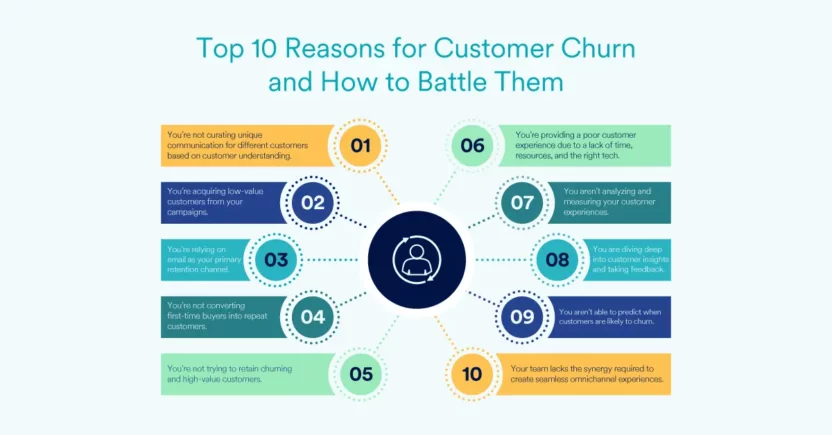
Let’s now redirect our focus on specific tactics and strategies that businesses can use to reduce customer churn:
Strategy #1: Drive meaningful customer communication and engagement
Regular communication with customers can help build strong relationships and keep them engaged. Businesses can use email marketing, social media, mobile app push notifications, etc., to keep customers informed about their products, services, and promotions.
Use-case: Spotify sends personalized playlists to customers based on their listening habits to keep them engaged and loyal:
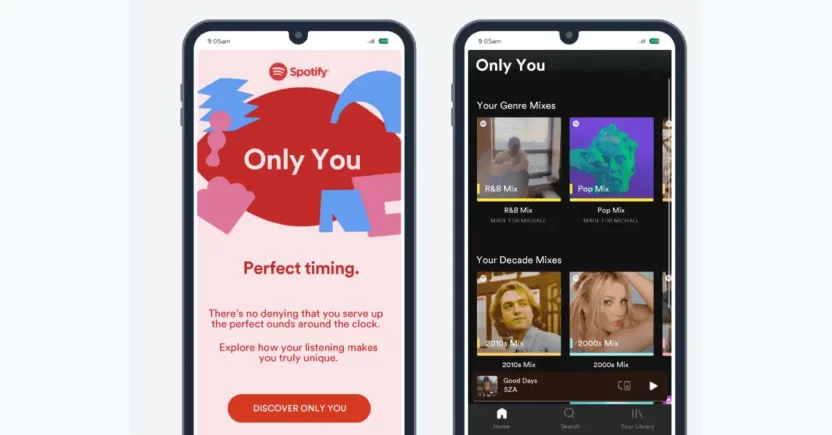
Image Source: Spotify
Strategy #2: Offering incentives to retain customers
Offering rewards, discounts, or freebies to customers who have been with the company for a long time or have made repeat purchases can encourage them to stay loyal.
Use-case: Starbucks offers free drinks and food items to its loyalty program members, keeping them coming back for more. In fact, according to the Harvard Business Review, “Starbucks attributes 40% of its total sales to the Rewards Program and has seen same store sales rise by 7%”:
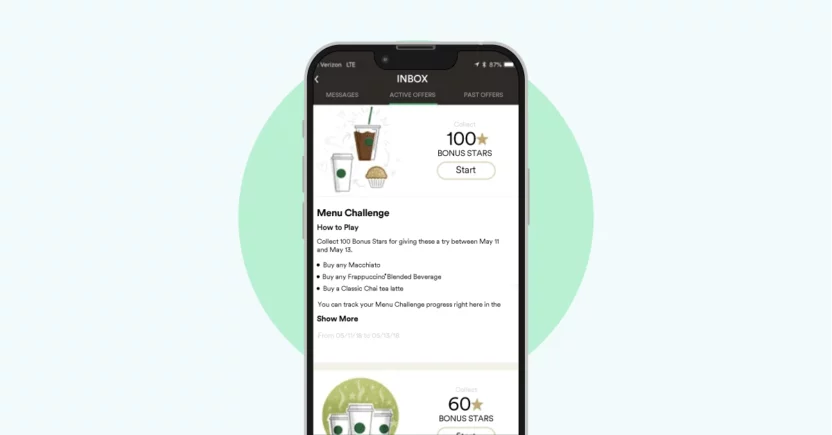
Strategy #3: Investing in customer relationship management (CRM) tools
CRM tools can help businesses manage customer interactions, monitor customer behavior, and analyze customer data to identify opportunities for engagement and retention.
Use-case: MoEngage’s modern platform helped 6thStreet, the e-commerce arm of The Apparel Group, headquartered in Dubai, achieve:
- 4X growth in CRM revenue contribution
- 24% uplift in repeat purchases
- 2X improvement in first-time purchase rates
- 55% increase in CTR through A/B testing and localization
The brand was able to:
- Eliminate silos using channel-specific tools
- Consolidate the tech stack
- Understand the customer behavior and friction points
- A/B test message variants and engage customers with the winning (personalized) message variant
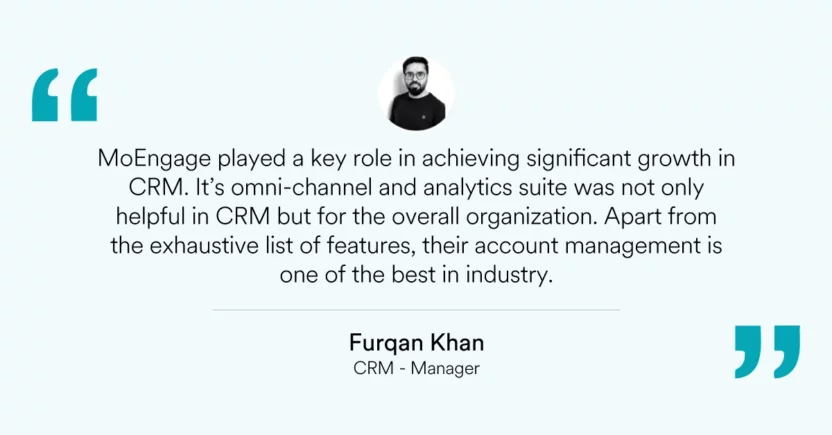
Strategy #4: Provide excellent customer service
Businesses should ensure that they provide prompt and efficient service to resolve customer issues and complaints.
For example, Amazon has a 24/7 customer service team that responds promptly to customer queries and concerns.
Strategy #5: Use customer feedback to improve products and services
Gathering and analyzing customer feedback can help businesses identify areas where they can improve their products and services to better meet customer needs.
Use-case: Airbnb collects feedback from customers after every stay to improve its services and offer a better customer experience:
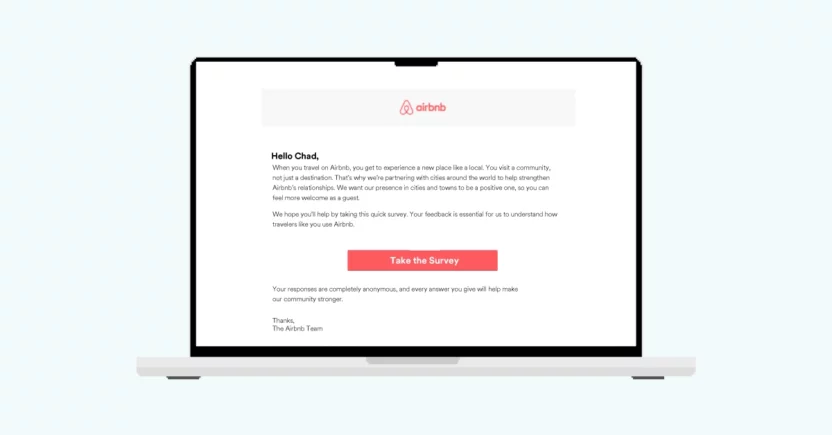
| The takeaway: By implementing these strategies and tactics, you can reduce customer churn and improve customer retention. Remember that the end goal is to build strong relationships with your customers and establish loyalty as well as encourage repeat business. |
Measuring and Analyzing Churn: What It Takes
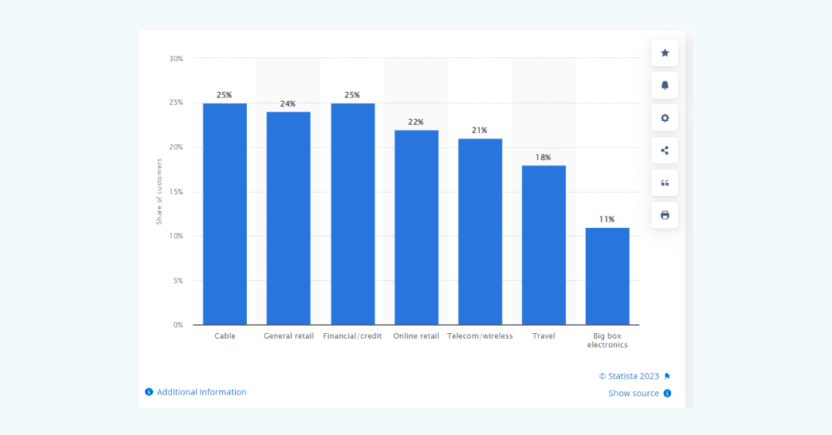
Moving on, let’s now understand how to analyze and measure churn rates and trends, as well as how to use this data to make decisions and optimize retention strategies:
Tip #1: Define what churn means for your business:
Before you can analyze and measure churn, you need to define what it means for your business. For instance, for your organization, the ‘churn rate’ can be something as simple as understanding the number of customers who cancel their subscriptions over a period of time or those who do not renew their subscriptions and stop using your product altogether.
Tip #2: Calculate your churn rate:
Once you have defined what churn means for your business, you can start calculating your churn rate. It is typically calculated as the percentage of customers who have churned within a given period (e.g., a month or a quarter).
The end goal is to calculate and increase the customer lifetime value.
Tip #3: Identify key trends:
Analyzing your churn rate over time can help you identify trends and patterns in customer behavior. For example, you may notice that churn rates tend to spike during certain times of the year or after specific events.
Tip #4: Analyze the data:
Once you have identified trends in your churn rate, you can start analyzing the data to understand why customers are leaving. The idea is to analyze customer feedback and examine customer behavior data to identify patterns.
Tip #5: Develop retention strategies:
Based on your analysis, you can develop retention strategies to reduce customer churn. The idea is to improve your product or service offerings, enhance customer support, and launch engaging marketing campaigns to win back churned customers.
Tip #6: Monitor progress of retention strategies:
It’s essential to monitor the impact of your retention strategies on your churn rate. Enter: Analytics tools!
These tools can:
- Help you segment customers based on demographics, behavior, or other factors
- Identify trends in your data over time
- Analyze key performance indicators (KPIs) for each strategy, viz. conversion rates, bounce rates, time on site, and engagement metrics
- Offer actionable insights on which strategies are performing well and which ones need improvement
- Provide remediation steps you can take to improve your retention strategy
- Enable you to compare the performance of different strategies side by side
| The takeaway: Measuring and analyzing churn is a critical component of any successful retention strategy. By understanding why customers are leaving and developing targeted retention strategies, businesses can improve customer satisfaction and reduce churn rates over time. |
Case Studies of Brands That Have Successfully Reduced Churn
Let’s look at a few real-world examples of businesses that have successfully implemented churn prevention strategies and what they did to achieve outstanding results:
1.) Netflix: Created Original Content & Personalized Recommendations
In the early days of the streaming service, Netflix was struggling with a high churn rate due to its limited content selection.
However, the company started investing heavily in creating original content, which helped it retain subscribers. Netflix also implemented a personalized recommendation system that suggested relevant content to customers based on their viewing habits:
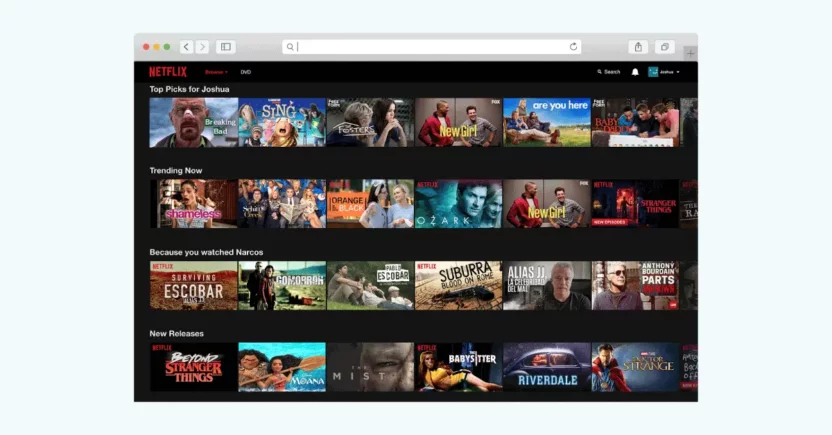
2.) Spotify: Improved Customer Support and Created Personalized Experiences
Spotify has been able to reduce churn by 68%. Sounds impressive, right? The brand was able to achieve this by improving its consumer experience and removing the option wherein customers could cancel the account themselves.
Instead, when someone wanted to cancel, the brand made it really easy to contact them. Customers could live chat with the team on the spot or send a message directly from the app. Most of the time, the team would respond in a couple of hours, sometimes within minutes (or instantly, in the case of live chat).
Plus, the music streaming service used machine learning algorithms to create personalized playlists and recommendations for its customers:
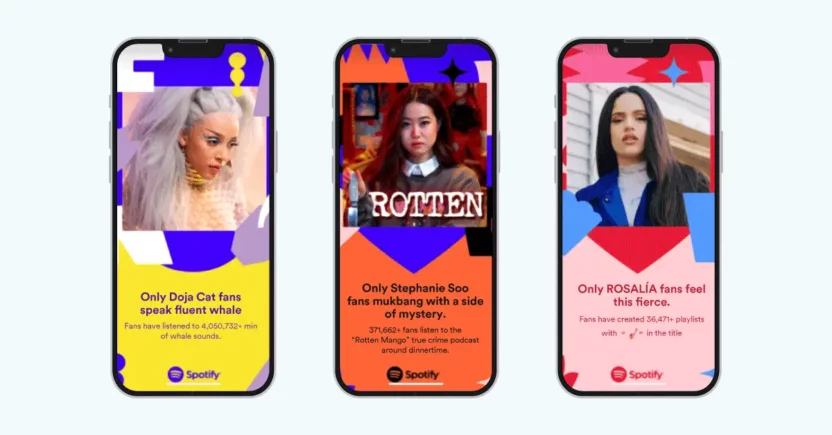
The brand has also introduced features like collaborative playlists, podcasts, and video content to keep customers engaged and reduce churn.
3.) Amazon Prime: Offered Members Useful Deals and Discounts
Amazon Prime has been successful in reducing churn by offering a variety of benefits to its subscribers and creating a sense of FOMO with its Prime Day deals:

The membership program includes free two-day shipping, access to exclusive deals, streaming of movies and TV shows, and unlimited access to a selection of ebooks, among other benefits. These benefits help to keep subscribers engaged and reduce churn.
The takeaway: These companies have been successful in churn prevention by:
|
In Summary
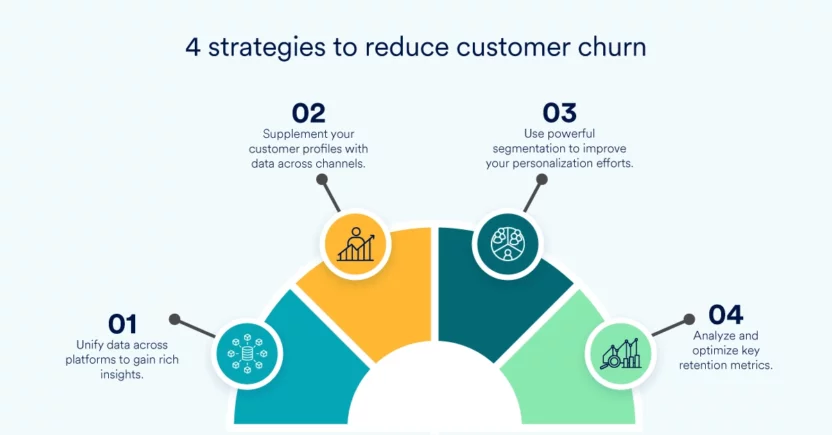
Preventing churn is every organization’s prerogative today. After all, losing customers can significantly impact revenue and growth.
To wrap up, here are some steps that you can take to drive churn prevention:
- Understand the reasons for churn: To prevent churn, you must first understand why customers are leaving. This requires:
- Analyzing customer data to identify patterns and trends in customer behavior
- Understanding the root cause of churn
- Taking targeted actions to address the underlying issues
- Provide exceptional and proactive customer service: Customers who feel valued and heard are more likely to stay loyal to a business. Providing proactive customer service, including responding promptly to inquiries and resolving issues quickly, can go a long way in retaining customers.
- Offer personalized experiences: Personalization is key to building long-term customer relationships. You can use data analytics to gain insights into customer preferences and behavior and leverage this information further to offer tailored experiences and promotions.
- Implement loyalty programs: It’s no secret that rewarding loyal customers can help keep them engaged and reduce churn. That is why you should focus on implementing a loyalty program that offers perks and benefits to incentivize customers to stay with the business.
- Regularly engage with customers: Regularly engaging with customers can help build trust and keep them invested in the business. You can send them newsletters, offer promotions, and seek feedback to improve products and services.
- Continuously improve products and services: Staying competitive in the marketplace requires you to continuously innovate and improve your products and services. This strategy is extremely useful in retaining existing customers and attracting new ones.
- Monitor customer satisfaction: Regularly monitoring customer satisfaction can help businesses identify areas for improvement and address issues before they lead to churn. You can conduct surveys, send out feedback forms, and collect customer reviews from your existing customers.
Embrace the churn prevention tips outlined above and give your business an edge over the competition.












